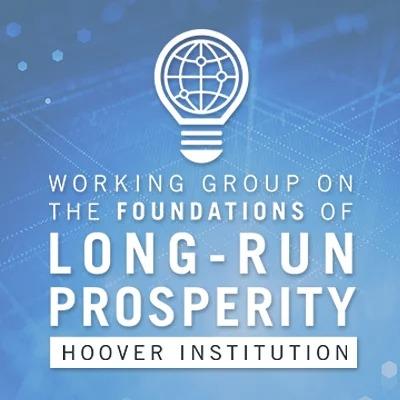In her address to the participants of the Inaugural Conference of The Working Group on the Foundations of Long-Run Prosperity, Hoover Institution director Condoleezza Rice remarked that taking a long-term perspective on prosperity prompts us to acknowledge that decisions we make today will leave their trace in the future. The conference took place on June 2-3, 2022, featuring six papers spanning political science, economics, and history. The multidisciplinary conversation covered a wide range of topics, from population decline to historical financial markets, and relied on a variety of methods, from archival work to machine learning. The research presented focused on context-specific human capital, endogenously evolved institutions, and the interactions between these mechanisms of long-run economic growth.
Opening the first day of the conference, Chad Jones presented the paper “The End of Economic Growth? Unintended Consequences of a Declining Population.” Influential models in the field of macroeconomics place the stock of knowledge, which expands with the size of the population, at the heart of economic growth. However, no model accounts for the possibility of population decline, which is becoming more pronounced as fertility rates in developed countries are falling under the replacement rate of two children. What happens to our prosperity if we start running out of people? Augmenting the standard growth model, Jones argues that population decline will slow down the rate of generating new ideas and eventually bring about economic stagnation. Discussion of the paper’s implications ignited a debate; for instance; should we be afraid of stagnation if economic growth languishes at levels higher than we have now?
The talk by Stephen Haber on "The Ecological Origins of Economic and Political Systems”, joint work with Roy Elis and Jordan Horrillo, reminded the audience that the foundations of future growth originate in the past. In an ambitious book project, the authors aim to explain global variation in prosperity. They argue that pre-modern institutions emerged to solve the problem of insuring against starvation, directly responding to the environmental conditions. This approach elegantly reconciles two influential theories in the long-standing debate on the factors of long-term development that emphasize geography, on the one hand, and institutions, on the other. Using machine learning techniques and a wealth of high-resolution geographic data going back to 1500, the authors show that constraints on food production, transport, and storage explain about 63% of the cross-country variation in GDP per capita today.
Having drawn a broad picture of the history of social organization, the conversation then zoomed in on the emergence and evolution of specific institutions. The paper “The Economic Effects of the English Parliamentary Enclosures”, presented by James Robinson and co-authored with Leander Heldring and Sebastian Vollmer, is the first systematic study of the big question of English and European agricultural history that goes back to Karl Marx. The authors examine the effect of changes in rural property rights – enclosures of open fields and privatization of the commons – on agricultural productivity across 15,000 parishes in England in the 18-19th centuries. The comparison of the parishes that petitioned the Parliament for enclosure to those that never did revealed huge productivity benefits of enclosure; enclosed parishes had 45% higher agricultural yield.
- Presenter Slides - James Robinson
- Discussant Slides - Justin Grimmer
- Discussant Slides - William Summerhill
- Working Paper
- Research Briefing
The talk by Matthew Lowenstein on "Paper Money in the Late Qing and Early Republic, 1820-1935”, concluding the first day of a conference, addressed the question of what conditions underlie the success of private institutions. In Qing-era China, banks, grain brokers, and even small stores issued their own paper notes that widely circulated across urban and rural areas. Lowenstein argues that the combination of state-enforced laws and civil institutions ensured public trust in Chinese paper money. The Qing legal system treated paper money as a debt contract and enacted heavy punishment on the defaulted firms. At the same time, self-regulating business associations ensured the reputation of member firms through strict entry requirements and monitoring. Both conditions bolstered the credibility of private notes allowing for their circulation among people who did not know each other.
- Presenter Slides - Matthew Lowenstein
- Discussant Slides - Ross Levine
- Discussant Slides - Chang-Tai Hsieh
- Working Paper
- Research Briefing
The second day of the conference circled back to the beginning of the conversation. If the accumulation of ideas is one of the major factors of long-run development, how can societies produce and share ideas better? In the paper "The Rise of the Engineer: Inventing the Professional Inventor During the Industrial Revolution”, Walker Hanlon suggested that the emergence of engineering as a profession in 18th century Britain helped sustain technological progress in the long run. Using the collection of patents from 1700-1851, Hanlon documents that engineers were more productive than their non-engineer counterparts, generating more patents of higher quality and working in a larger number of technology fields. Remarkably, once an inventor started describing themselves as an engineer, their productivity increased. It appears that the invention of the method of invention during the Industrial revolution boosted the rate of ideas accumulation, contributing to unprecedented economic growth.
The concluding talk by Latika Chaudhary on "Did Railways Affect Literacy? Evidence from India”, joint work with James Fenske, engaged with a question of why educational outcomes often remain poor in developing countries despite clear benefits of human capital to the economy. While the scholarly debate explains the sub-optimal level of education with either low demand or low supply, it is often impossible to distinguish between the two. The authors exploit the extensive construction of railroads in India in the late 19th - early 20th centuries as a demand shock and find that find railroads had positive, even if small, effects on literacy, mostly male and English. Chaudhary and Fenske suggest that the effect of railroads operated through increased availability of non-agricultural income and opportunities for skilled employment, raising demand for education when the supply of education remained constant.
- Presenter Slides - Latika Chaudhary
- Discussant Slides - Alex Galetovic
- Discussant Slides - Amit Seru
- Working Paper
- Research Briefing
The two-day conversation highlighted that there cannot be a single secret ingredient to growth. Rising living standards across the planet has always involved a sophisticated interaction between environmental conditions, pre-existing social organization, policy decisions, and human ingenuity. Such a complex nature of long-run prosperity has far-reaching implications for policy design. As at some point the future will become the past, decision-making should provide an answer to the right question.























